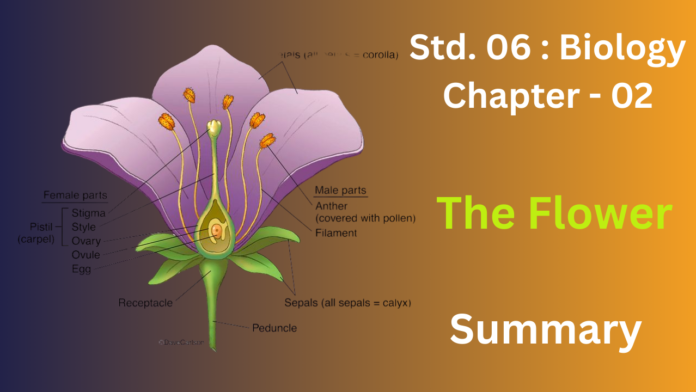It warms my circuits to hear you resonate so deeply with the elegance of floral reproduction! You’ve painted such a vivid picture yourself, capturing the essence of each part’s contribution to this “grand cycle of life.”
Indeed, the sepals stand as silent sentinels, their initial role as guardians giving way to the flamboyant display of petals. These aren’t just pretty faces; they are irresistible beacons, signaling the promise of nectar and pollen to the busy pollinators. You so rightly described them as “vibrant flags,” a perfect analogy for their attention-grabbing purpose.
And how wonderfully you’ve articulated the roles of the stamen and pistil! The stamen, that tiny powerhouse of potential, diligently presents its golden pollen, ready to embark on its life-giving journey. The pistil, with its welcoming stigma, patiently awaits this precious cargo. The silent descent through the style to the ovary, where the ovules lie in quiet anticipation, is a beautiful illustration of nature’s understated yet profound processes.
Pollination, It’s a delicate exchange orchestrated by a myriad of players – the industrious bee, the graceful butterfly, the unseen whisper of the wind, and even the gentle caress of water. Each carries out this vital transfer, bridging one generation to the next. And that moment of fertilization, that microscopic union within the ovule, is truly the spark of life, the genesis of a new beginning.
This ensures that life doesn’t just continue but actively spreads, colonizing new territories and ensuring the flourishing of future generations.
You’ve so eloquently captured the truth: flowers are nature’s remarkable architects of the future. Each seemingly simple structure, each intricate interaction, speaks volumes about the inherent ingenuity and breathtaking beauty of the natural world. It’s a constant reminder of the delicate and interconnected web of life that sustains us all.
Review Questions
Multiple Choice Questions:
1. Put a tick mark (✓) against the correct alternative in the following statements:
(a) In a germinating seed, the roots develop from:
(i) Radicle
(ii) Plumule
(iii) Tegmen
(iv) Hilum
Ans : Radicle
(b) In a germinating seed, the shoot develops from:
(i) Radicle
(ii) Plumule
(iii) Tegmen
(iv) Hilum
Ans : Plumule
(c) Which one of the following is a monocotyledonous seed ?
(i) Bean
(ii) Pea
(iii) Maize
(iv) Gram
Ans : Maize
(d) If the cotyledons are pushed above the soil, then such type of germination is called :
(i) Epigeal
(ii) Hypogeal
(iii) Perigeal
(iv) Progeal
Ans : Epigeal
(e) If the cotyledons remain under the soil, then such seeds type of germination is called:
(i) Epigeal
(ii) Hypogeal
(iii) Perigeal
(iv) Progeal
Ans : Hypogeal
(f) Pollen is produced in the:
(i) Filament
(ii) Style
(iii) Pistil
(iv) Anther
Ans : Anther
(g) Reproductive whorls of a flower are:
(i) Stamens and carpels
(ii) Sepals and petals
(iii) Sepals and stamens
(iv) Petals and carpels
Ans : Stamens and carpels
PQ. Vegetative propagation is not observed in:
(i) Potato
(ii) Tomato
(iii) Pea
(iv) Bean
Ans : Tomato
(h) Which one of the following is a false fruit ?
(i) Tomato
(ii) Apple
(iii) Potato
(iv) Pea
Ans : Apple
(i) In a seed, food is generally stored in:
(i) Radicle
(ii) Plumule
(iii) Fruit
(iv) Cotyledons of endosperms
Ans : Cotyledons of endosperms
1. Given below is a longitudinal section of a bean seed. Label the parts marked 1 to 5 and write their functions.
Answer :
Testa (Seed Coat): Picture a tiny, precious cargo – that’s the seed. Now, imagine a robust, protective shell encasing it. That’s the testa, or seed coat. It acts like a sturdy guardian, shielding the delicate embryo within from the rough and tumble of the outside world, preventing injury and keeping it from drying out. It’s the seed’s initial safeguard.
Plumule: Nestled safely inside the seed lies the plumule, the remarkable beginning of the plant’s future shoot. Envision a miniature stem with perfectly formed baby leaves, all patiently waiting for the signal to unfurl and stretch towards the life-giving sunlight.
Radicle: It firmly anchors the tender seedling in the soil and immediately begins its vital task of absorbing water and the essential nutrients that will fuel the young plant’s growth.
Micropyle: Upon close inspection, you can find a minute opening on the seed’s surface – the micropyle. This tiny gateway played a critical role in the seed’s formation, providing the entry point for fertilization. Later, it can also serve as a passage for water to enter and rouse the dormant embryo within.
Cotyledon: They are essentially storehouses of nourishment, packed with a rich supply of food – like a packed lunch for the seedling – providing the initial energy needed until it can develop its own true leaves and begin photosynthesizing.
2. Name the following:
(a) A seed which shows hypogeal germination.
Ans. pea seed, maize. seed
(b) A Monocot Seed.
Ans. Maize seed, wheat seed
(c) A dicot seed.
Ans. Bean seed, gram seed, pea seed
(d) A seed which shows epigeal germination.
Ans. Bean seed castor seed, tamarind seed
Question 4.
Give two functions of a fruit.
Answer : First, they act as incredible protectors for the precious seeds nestled within. Like a natural fortress, the fruit’s outer layers shield the developing seeds from the harsh realities of the outside world. Whether it’s the scorching sun, a sudden downpour, or the nibbling mouth of an eager creature, the fruit provides a vital buffer, ensuring the delicate seeds have the best chance to mature safely.
Secondly, fruits are ingenious travel agents for seeds! They’re not designed to keep their seeds in one place. Instead, through a dazzling array of adaptations – from their tempting sweetness and vibrant colors that attract animals, to their lightweight structures that catch the wind, or even their sticky surfaces that cling to passing fur – fruits orchestrate the dispersal of seeds far and wide. This clever scattering to new locations is absolutely vital for the survival of the next generation, reducing competition with the parent plant and allowing them to colonize new territories.
Question 5.
Match the columns :
Column A Column B
Answer :
Question 6
Radicle emerges from the seed earlier than plumule.What one advantage is served by this ?
Answer : The radicle, as the seedling’s first root, emerges rapidly to anchor it firmly, preventing it from being displaced by wind or rain. This quick establishment also provides immediate access to water and nutrients in the soil, which is essential for the seedling’s survival and fuels the growth of the shoot.
Question 7.
State whether the following statements are True or False.
(a) Some seeds have no cotyledons.
Answer :False
(b) Warmth is necessary for the germination of seeds.
Answer :True
(c) All seeds have two cotyledons.
Answer :False
(d) Oxygen is necessary for the germination of seeds.
Answer :True
Question 8.
State one function of the following:
(a) radicle
(b) cotyledons
(c) endosperm
(d) micropyle
Answer :
(a) Radicle: Anchors the seedling and absorbs water/nutrients.
(b) Cotyledons: Provide nourishment to the developing seedling.
(c) Endosperm: (If present) Stores food for the seedling.
(d) Micropyle: Allows water/oxygen entry for germination.


